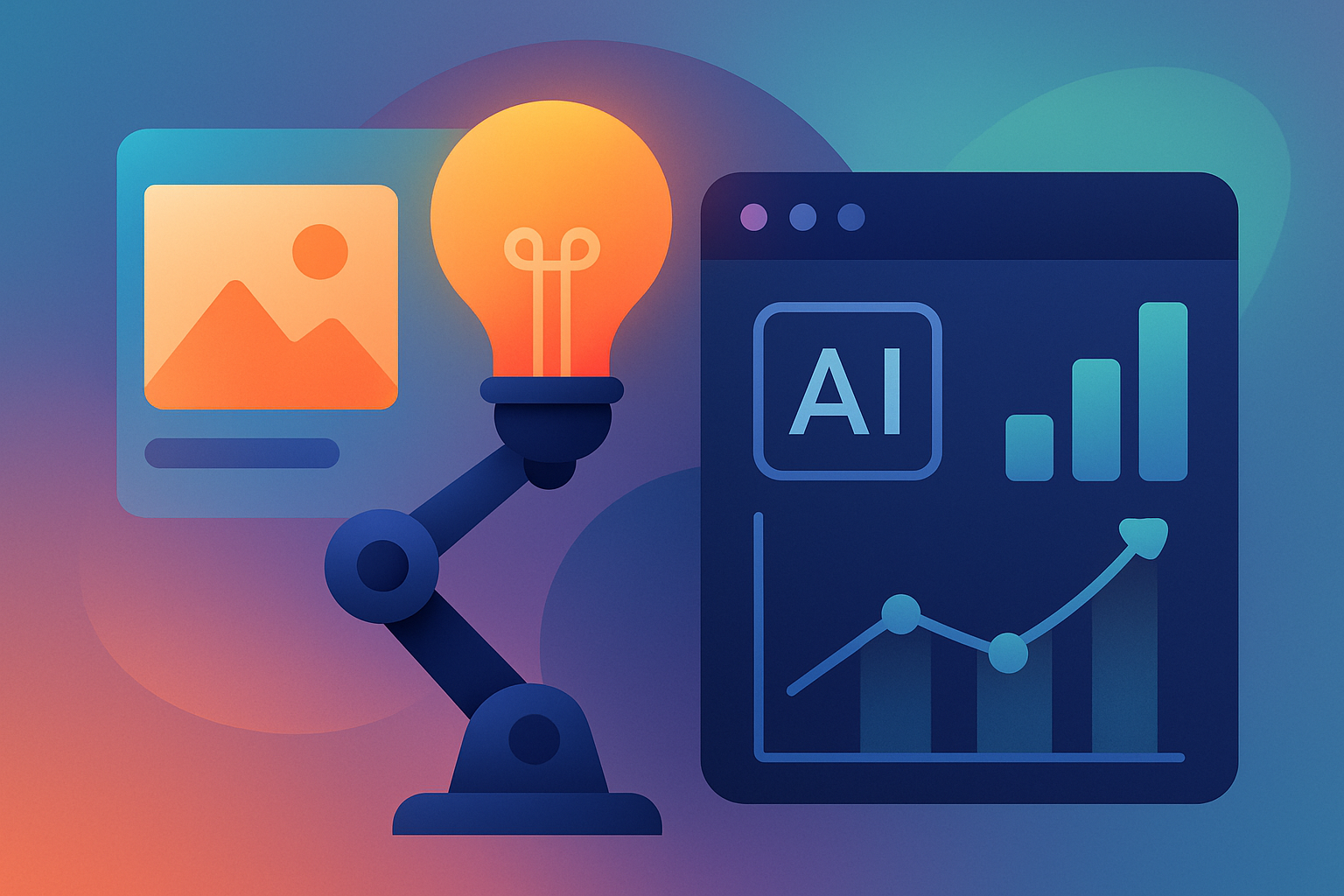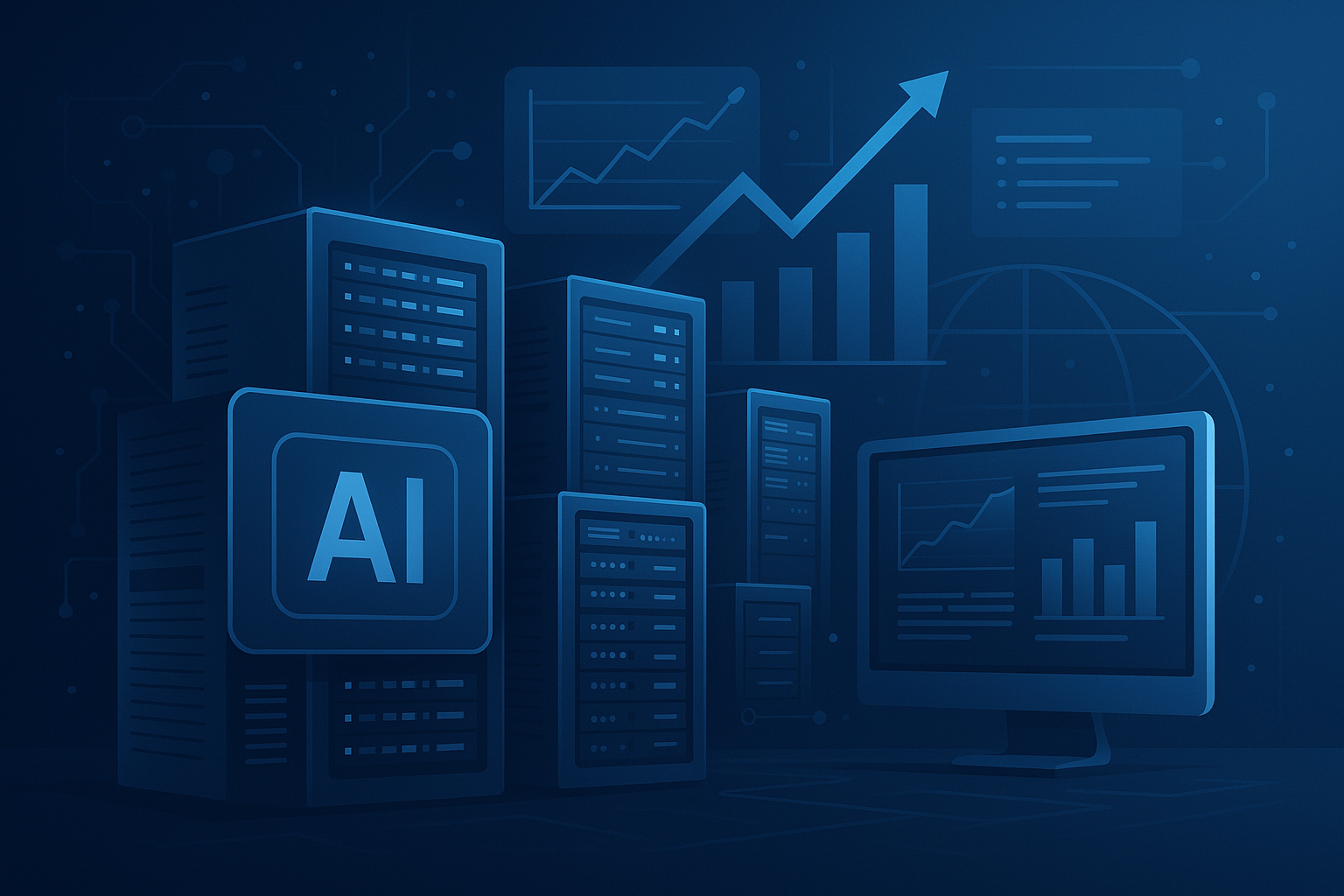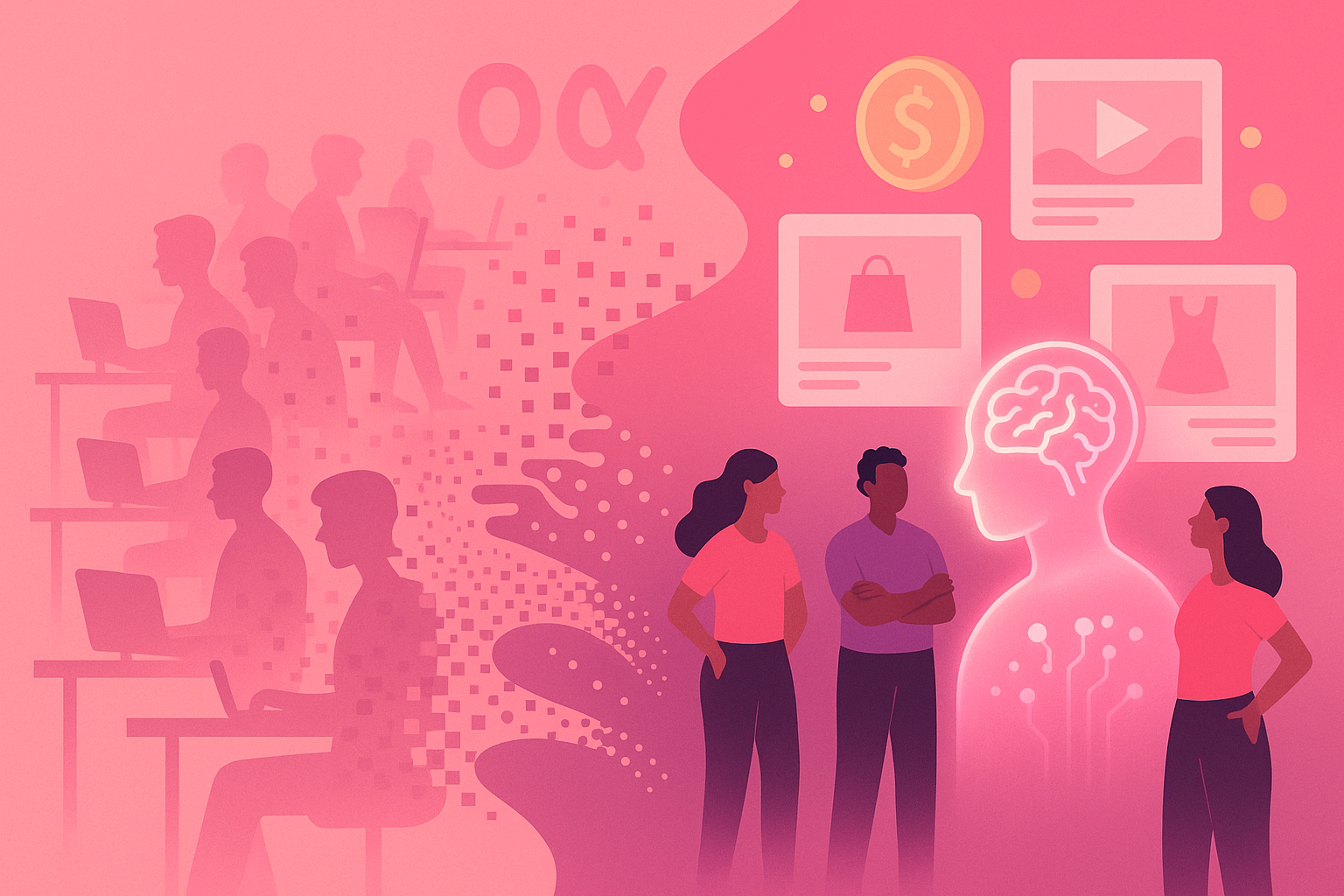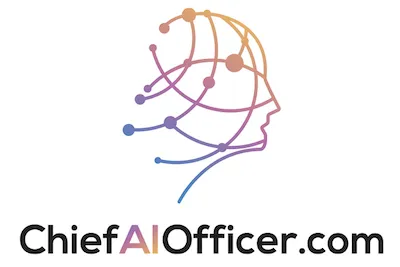Forever 21 built a complete marketing campaign in one day using generative AI and Meta’s Advantage+ platform. Not a draft requiring weeks of refinement. A production-ready campaign that delivered 66% higher return on investment, 71% increase in click-through rates, and 19% improvement in cost per click compared to traditional campaigns taking weeks to develop.
The one-day timeline matters less for speed bragging rights than for what it reveals about marketing bottlenecks. Traditional campaigns spend weeks on creative development, audience research, message testing, and approval cycles. Forever 21’s AI-powered workflow compressed these weeks into hours by automating creative generation, targeting optimization, and performance prediction simultaneously rather than sequentially.
Here’s the counterintuitive insight: the campaign didn’t perform better because AI is more creative than human marketers. It performed better because AI tested thousands of creative variations, targeting combinations, and message approaches that human teams would never have time to explore. The winning campaign existed in the possibility space all along. AI just found it faster by exploring far more options than manual testing could.
The Traditional Campaign Timeline Problem
Fashion retail marketing traditionally operates on timelines incompatible with trend-driven consumer behavior. A marketing team identifies an emerging trend, briefs creative agencies, waits for concepts, provides feedback through multiple revision rounds, conducts consumer testing, secures executive approvals, and finally launches campaigns weeks or months after initial conception.
By the time campaigns launch, trends often evolved or faded entirely. A social media trend dominating feeds in January might be passé by March when the campaign finally goes live. Fashion’s rapid cycle creates fundamental tension: campaigns require weeks to develop but trends change in days.
The timeline constraints also limit testing and optimization. With weeks invested in developing specific creative approaches, teams commit to those directions rather than exploring alternatives. Testing multiple creative directions simultaneously would require proportionally multiplying timeline and budget, making comprehensive exploration economically impractical.
The approval cycles compound delays. Each stakeholder review introduces days or weeks as busy executives schedule time to evaluate work, provide feedback, and request revisions. A campaign touching multiple departments might cycle through six approval stages consuming weeks even when actual feedback takes minutes.
Forever 21 recognized that traditional timelines meant they were consistently marketing yesterday’s trends to audiences already moving to tomorrow’s interests. Compressing campaign development from weeks to a single day enabled responding to trends while they remained relevant rather than launching campaigns after trends peaked.
The One-Day Campaign Development
Building a production-ready campaign in one day required fundamentally different workflows than traditional approaches. Forever 21 didn’t just work faster. They restructured the entire development process around AI capabilities that don’t exist in human-powered workflows.
The generative AI created hundreds of creative variations simultaneously: different images, copy variations, calls-to-action, and visual styles. Rather than briefing designers who produce 3-5 concepts over weeks, the AI generated complete ad variations in hours, providing far greater creative diversity for testing than traditional processes could produce.
Meta’s Advantage+ platform handled targeting optimization automatically, analyzing which audience segments responded to which creative variations and dynamically allocating budget to best-performing combinations. Traditional campaigns lock in targeting strategy during planning, then discover weeks later whether those targeting decisions were optimal. The AI adjusted targeting continuously based on real performance data.
The workflow also eliminated sequential dependencies that consume time in traditional development. Instead of completing creative, then targeting strategy, then copy, then approvals, the AI generated all elements simultaneously. Creative generation, targeting optimization, and performance prediction happened in parallel rather than series, collapsing timeline through parallelization.
The one-day timeline also benefited from eliminating approval bottlenecks. The AI operated within guardrails defining brand guidelines, acceptable messaging, and budget parameters. Work meeting those criteria proceeded automatically without requiring executive review for each decision. This pre-approved framework enabled autonomous operation that traditional workflows requiring constant human approval cannot achieve.
The 66% ROI Improvement
The 66% increase in return on investment represents the most concrete validation of the AI campaign’s business value. Understanding where this improvement comes from reveals why AI-powered marketing outperforms traditional approaches beyond just speed advantages.
The ROI improvement likely comes from multiple sources that compound together. Better targeting reaching higher-intent audiences increases conversion rates 20-30%. More relevant creative matching audience preferences improves engagement 15-25%. Optimal timing delivering messages when audiences are most receptive adds another 10-15%. These factors multiply: 1.25 × 1.20 × 1.12 = 1.68, or 68% improvement. The reported 66% aligns with these compounding effects.
The improvement also reflects reduced waste from showing ads to irrelevant audiences or at suboptimal times. Traditional campaigns might reach millions of impressions with only 5-10% targeting truly high-intent prospects. AI targeting that identifies and focuses on the 30-40% highest-intent audience segments dramatically improves efficiency even before creative optimization.
The dynamic optimization also contributes substantially. Traditional campaigns lock in creative and targeting at launch, then run for weeks before making adjustments based on performance data. AI campaigns optimize continuously from the first impression, learning which combinations perform best and immediately shifting budget to winning approaches. This real-time optimization captures better performance throughout the campaign rather than just after analyzing post-campaign data.
The 66% improvement also benefits from testing scale impossible in traditional campaigns. Forever 21’s AI likely tested hundreds of creative and targeting combinations simultaneously, identifying top performers from this broad exploration. Traditional campaigns might test 3-5 variations due to time and budget constraints, missing superior approaches outside that limited testing scope.
The 71% Click-Through Rate Increase
The 71% increase in click-through rates indicates the AI-generated creative and targeting resonated far more effectively with audiences than traditionally developed campaigns. CTR improvements of this magnitude come from fundamental differences in relevance and appeal rather than just incremental optimization.
The creative relevance particularly drives CTR improvements. The AI generated variations incorporating trending styles, colors, and aesthetics that aligned with current social media trends rather than using design approaches developed weeks earlier based on outdated trend research. This timeliness made ads feel current and relevant instead of dated.
The copy optimization also contributed significantly. The AI tested hundreds of headline and copy variations, identifying language patterns that drove engagement for specific audience segments. Different demographics respond to different messaging: some prefer direct benefit claims, others respond to social proof, and others engage with aspirational lifestyle messaging. The AI matched copy styles to audience preferences rather than using single copy approaches for all segments.
The visual optimization similarly improved performance. The AI tested different product presentations, background styles, and layouts, identifying which visual approaches captured attention and drove clicks. Some audiences respond to minimalist clean aesthetics, others prefer bold colorful designs, and others engage with lifestyle imagery. The AI discovered these preferences through testing rather than assuming single design approaches work universally.
The timing optimization also matters for CTR. Showing ads when specific audiences are most active and engaged increases likelihood of clicks compared to showing the same ads at random times. The AI identified optimal timing patterns for different segments, delivering messages when each audience segment was most receptive.
The 19% Cost-Per-Click Improvement
The 19% improvement in cost per click demonstrates that the AI campaign achieved better results while simultaneously reducing costs. This dual benefit (better performance AND lower costs) represents the ideal outcome that traditional marketing optimization struggles to achieve.
The CPC improvement comes from multiple efficiency gains. Better targeting means paying only for impressions reaching genuinely interested audiences rather than wasting budget on irrelevant exposures. Higher CTR means each impression has greater conversion probability, making each dollar spent more productive. The combination of reaching the right people with the right creative naturally drives down cost per click.
The dynamic budget allocation also reduces CPC by concentrating spending on best-performing combinations. Traditional campaigns divide budget across planned creative and targeting combinations, continuing to spend on underperforming variations throughout the campaign duration. The AI immediately identifies underperformers and reallocates their budget to high-performers, eliminating waste that inflates average CPC.
The auction dynamics on Meta’s platform also reward better-performing ads with lower costs. When ads generate high engagement, Meta’s algorithms perceive them as providing good user experiences and reward them with better positioning at lower costs. The AI-generated campaigns achieving 71% higher CTR triggered these quality rewards, further reducing costs beyond just the direct efficiency improvements.
The 19% CPC improvement compounding with 71% CTR increase creates multiplicative campaign effectiveness. Not only does each click cost less, but the campaign generates far more clicks. The combined effect means substantially greater traffic at modestly lower total spend, dramatically improving campaign economics.
The AI-Generated Digital Models Strategy
Forever 21’s use of AI-generated digital models and images represents broader transformation in fashion marketing content creation. This approach enables producing marketing content at scale and speed impossible with traditional photography and modeling.
Traditional fashion photography requires booking models, photographers, and studio space; transporting clothing samples; conducting shoots that might take full days; then editing and processing images for final use. This process takes weeks and costs thousands per final image, limiting how much content brands can produce and how frequently they can update visual assets.
AI-generated models eliminate most of these constraints. The same clothing items can be shown on infinite AI-generated models with diverse appearances, body types, and styling, creating extensive content libraries from single product samples. This diversity enables showing products on models that audiences can relate to rather than limiting representation to the specific models available for photoshoots.
The speed also enables responding to trends immediately. When a new styling trend emerges, AI can generate images showing Forever 21 products styled according to that trend within hours. Traditional photography requiring scheduling and execution would miss the trend’s peak relevance by the time new imagery launched.
The cost economics also transform what’s possible. At a fraction of traditional photography costs, Forever 21 can generate 10x or 100x more content, enabling extensive A/B testing, personalization for different audience segments, and frequent content refreshes maintaining visual novelty that engages audiences.
The approach does face criticism about displacing human models and potentially unrealistic beauty standards if AI-generated models don’t represent genuine human diversity. Forever 21 likely balances AI-generated content with traditional photography to maintain authenticity while capturing AI efficiency benefits.
The Real-Time Behavioral AI Integration
Forever 21’s deployment of in-session behavioral AI for real-time personalized offers and dynamic segmentation achieved substantial performance improvements: 23.6% increase in conversion rate, 23.3% increase in revenue per visit, and 10x immediate ROI on marketing investments.
The behavioral AI analyzes visitor actions in real-time during website sessions: which products they view, how long they spend on different categories, what they add to cart but don’t purchase, and how they navigate through the site. This behavioral data reveals purchase intent and preferences far more accurately than demographic data or past purchase history alone.
The real-time personalized offers respond to these behavioral signals immediately. A visitor spending significant time viewing winter coats but not purchasing might receive a discount offer or free shipping promotion while still browsing, capturing the conversion opportunity before they leave. Traditional marketing sends promotions hours or days later when purchase intent has cooled.
The dynamic segmentation groups visitors by behavior patterns rather than static demographics. High-intent visitors showing strong purchase signals receive different treatment than browsers showing initial interest. This real-time segmentation enables targeted interventions appropriate to each visitor’s current mindset rather than generic approaches applied equally to all visitors.
The 23.6% conversion rate improvement and 23.3% revenue per visit increase demonstrate that personalized interventions based on real-time behavior substantially outperform generic promotions sent to all visitors regardless of their current intent or interests. The behavioral targeting ensures offers reach visitors most likely to respond when they’re most likely to convert.
The 10x immediate ROI validates that behavioral AI investments pay for themselves rapidly rather than requiring extended periods to demonstrate value. The technology likely costs substantially less annually than the incremental revenue it generates monthly, creating exceptionally favorable economics.
The Meta Advantage+ Platform Integration
Forever 21’s use of Meta’s Advantage+ platform represents strategic decision to leverage platform-provided AI capabilities rather than building entirely proprietary systems. This approach accesses sophisticated AI that would be impractical to develop internally.
Advantage+ provides automated campaign optimization handling creative testing, audience targeting, and budget allocation without requiring manual management of each element. Advertisers define campaign objectives and constraints, then Advantage+ autonomously optimizes toward those goals using Meta’s extensive data about user behavior, preferences, and conversion patterns.
The platform integration provides access to Meta’s investment in AI research and development. Meta spends billions annually advancing advertising AI to improve platform performance for all advertisers. Leveraging Advantage+ gives Forever 21 access to this investment without requiring similar internal spending on AI development.
The platform also provides scale benefits. Meta’s AI trains on billions of ad impressions across millions of advertisers, learning patterns that no single advertiser could discover from their own campaigns alone. This collective intelligence improves performance for all Advantage+ users including Forever 21.
The integration also simplifies deployment. Building equivalent campaign optimization capabilities internally would require hiring AI specialists, developing custom algorithms, integrating with Meta’s APIs, and continuously maintaining and improving the system. Using Advantage+ provides these capabilities through platform features requiring minimal technical integration.
The Gen Z and Millennial Targeting Strategy
Forever 21’s AI-powered marketing specifically targets Gen Z and Millennial consumers whose preferences and behaviors differ substantially from older demographics. The AI enables targeting approaches these audiences prefer rather than applying generic marketing approaches.
Gen Z and Millennials expect personalization and authenticity in marketing. Generic mass-market advertising feels inauthentic to audiences accustomed to curated social media feeds and personalized recommendations. The AI enables delivering genuinely personalized experiences matching individual preferences rather than broad demographic targeting.
These audiences also respond to visual-first content and rapid trend adoption. Forever 21’s AI-generated imagery and one-day campaign development enable the visual novelty and trend responsiveness that engages these demographics. Traditional marketing’s slower pace produces content that feels dated to audiences moving quickly between trends.
The social media native nature of these audiences also affects channel strategy. Forever 21’s focus on Meta platforms aligns with where Gen Z and Millennials spend time rather than investing heavily in traditional media these demographics largely ignore. The AI optimization within these platforms maximizes performance where the target audiences actually exist.
The price sensitivity and value consciousness of these demographics also informs promotion strategy. The behavioral AI’s ability to deliver targeted offers to high-intent visitors enables capturing conversions from price-conscious consumers who might not purchase without incentives, while avoiding unnecessary discounting to customers willing to pay full price.
The Broader Digital Transformation
Forever 21’s AI-powered marketing represents part of broader digital transformation including AI-generated content, real-time behavioral marketing, and automated campaign optimization. This comprehensive approach creates compound benefits exceeding what isolated AI applications would deliver.
The AI-generated content provides the creative assets that AI-powered campaigns deploy. The behavioral targeting identifies high-intent visitors for AI-optimized ad campaigns to target. The automated campaign optimization ensures efficient budget allocation across all these AI-enhanced capabilities. These integrated capabilities create more value together than the sum of their individual contributions.
The digital transformation also addresses Forever 21’s strategic challenges: competing with fast-fashion rivals and digitally native brands while maintaining relevance to trend-conscious younger consumers. AI enables the speed, personalization, and efficiency necessary to compete effectively in this environment.
The transformation also positions Forever 21 to continue advancing capabilities as AI technology improves. Having established AI-powered workflows, integrating enhanced AI capabilities becomes incremental advancement rather than requiring wholesale process redesign. This creates paths for continuous improvement as technology evolves.
The Competitive Implications
Forever 21’s AI marketing success creates competitive pressure across fashion retail. Brands observing 66% ROI improvements and one-day campaign development face strategic questions about their own marketing approaches.
The speed advantage particularly matters in fashion where trends change rapidly. Competitors taking weeks to develop campaigns will consistently market outdated trends while Forever 21 responds to current interests. This timeliness advantage compounds over time as audiences increasingly associate Forever 21 with current trends and competitors with dated approaches.
The efficiency advantages also create sustainable competitive moats. Forever 21 can achieve superior results at lower costs, enabling either higher profitability or more aggressive marketing spending than competitors achieving worse results with higher costs. This economic advantage grows over time as AI capabilities improve and accumulated data makes targeting more effective.
The creative scale advantages also differentiate. Competitors limited by traditional content creation can’t match Forever 21’s volume and diversity of creative assets. This content advantage enables more extensive testing, better personalization, and more frequent refreshes maintaining novelty that engages audiences.
Your Strategic Response Path
For fashion retailers and brands targeting trend-conscious consumers, Forever 21’s approach demonstrates that AI-powered marketing delivers measurable advantages rather than just incremental improvements.
Start by assessing current campaign development timelines and identifying bottlenecks preventing rapid response to trends. The gap between trend emergence and campaign launch represents opportunity for AI compression of development cycles.
Evaluate AI-powered creative generation capabilities for producing diverse content at scale. The cost per asset created through AI likely runs 10-100x less than traditional content creation, dramatically changing economics of testing and personalization.
Integrate platform-provided AI capabilities like Meta’s Advantage+ rather than requiring internal AI development. Platform AI provides sophisticated capabilities without extensive technical investment or specialized hiring.
Implement behavioral AI for real-time website personalization targeting high-intent visitors with appropriate offers. The 23%+ improvements in conversion and revenue demonstrate substantial value from this capability.
The Future of Fashion Marketing
Fashion marketing is transitioning from planned campaigns developed over weeks to dynamic AI-generated content responding to trends in real-time. The brands that master this transition will dominate trend-conscious consumer segments through superior relevance and engagement.
Forever 21 proved that one-day campaign development achieving 66% higher ROI is achievable reality rather than theoretical possibility. The question isn’t whether AI-powered marketing works. It’s whether your brand will adopt it while it still provides competitive advantages or wait until competitive pressure forces reactive adoption after competitors have built insurmountable leads.
Building campaigns in one day while achieving 66% better ROI isn’t about working faster. It’s about AI exploring possibility spaces that humans don’t have time to search manually.




